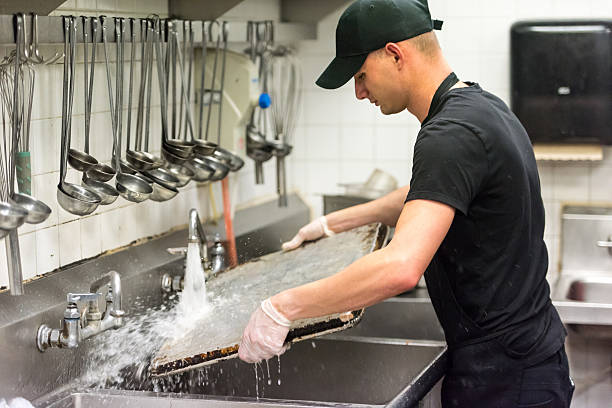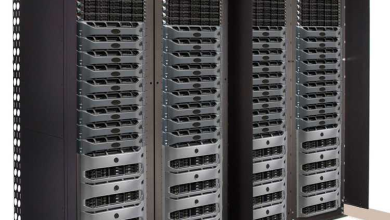
Stainless steel: the definition
Stainless steel is a very popular material in the workplace, especially in collective catering and the catering trades, due to its many properties: food-grade, hygienic, heat-resistant, impact-resistant, aesthetic , easy to maintain, corrosion resistant and durable.
But it must be professionally cleaned with suitable products to maintain its corrosion resistance over the long term. It is therefore essential to respect certain rules that we present to you here.
Stainless steel is mainly composed of iron and carbon for the steel part, to which chromium is added, which gives it its stainless properties. It is then possible to add other elements – nickel, titanium, molybdenum,… which give it an additional and specific property.
In contact with air humidity or water, the chromium contained in the stainless steel forms a layer of chromium oxide.
It is precisely this natural protection, called passive film, which prevents stainless steel from rusting.
How to clean stainless steel in professional kitchens?
It is important to clean stainless steel regularly to remove the dirt that settles on it.
- A simple maintenance carried out using a sponge or a dishcloth (one shiny finishes) and detergent products is enough to preserve its initial appearance.
- It must be followed by abundant rinsing with clear water.
- And wiping with a clean cloth to avoid moiré effects – chamois leather or rubber squeegee depending on the surface.
Don’t wait for organic dirt to dry – baked on grease, leftover food, etc.
Caution:
Conversely, chlorides (salts) are likely to lead to corrosion. Main characteristic of cooking salt, the quality of sea spray, tap water and certain active ingredients present in disinfectant products and use it with caution even if disinfection proves necessary to comply with health standards hygiene in the food industry.
In any case, abundant rinsing is the most effective solution against corrosion. It eliminates salt and active ingredients and reinforces the effectiveness of the protective layer of stainless steel.
Preserving kitchen stainless steel: what are the rules to follow?
In general, you should check with your equipment manufacturer or professional cleaning product supplier :
- Safety data
- That the product used is compatible with the type of stainless steel you want to clean: worktops and other kitchen surfaces, utensils, furniture, equipment, etc.
Cleaning stainless steel: recommended products and products to avoid
Stainless steel: recommended cleaning products
- On all fragile surfaces in contact with foodstuffs.
- Electric, powerful and compact
- Foldable handle
- Maintenance contract
- Training and start-up
- After-sales service throughout France
- Many models in stock
- Window products. For example, the glass and stainless steel disinfectant cleaner.
Soap-like detergents - Soda-based degreasers to remove baked-on grease.
- Scouring creams for very adherent stains.
- Solvents – for grease or oil stains.
- Alkaline strippers based on soda, or solvents to remove graffiti.
For example, Multi-Purpose Ultra Powerful Stain Remover - Pressure washers – hot or cold water.
- De-greasing solutions based on soda and potash.
- Virucidal multi-surface disinfectant products
For example the multi-surface virucidal spray
Stainless steel: products to avoid
- Scouring powders which alter the shine of surfaces, modify their appearance and can scratch certain stainless steel surfaces such as mirror polish, for example.
- All products containing bleach or other chlorinated derivatives.
- professinal cleaning products and deoxidizers for silverware.
Stainless steel: products to be used with caution:
- Bleach. To use on stainless steel, we must dilute it in cold water. Respect the dosage, the temperature, and limit contact time to what is strictly necessary. Follow disinfection with abundant rinsing with clear water.
- Solvents to remove very stubborn dirt.
- Acid products – pH less than 7. You should use these products only in very specific cases. (scaling operations for example). Choose phosphoric acid or nitric acid products that are specially planned for stainless steel.
Stainless steel: prohibitions
- Concentrated or hot disinfectants.
- Pure acid products or mixed with alkaline (basic) products.
- Disinfectants or descaling products on very hot surfaces.
- Hot bleach, even diluted, is strictly prohibited.
- All products based on hydrochloric acid, even diluted and cold. They are strictly prohibited.
The right equipment to clean stainless steel equipment
For cleaning tools, in the case of very stubborn dirt, use clean equipment and rub, in the direction of the initial polishing if there is one, using brushes made of stainless steel wool or nylon – scotch-brite, except on polished stainless steel because they can scratch. Ban metal sponges and brushes or ones with steel bristles.
Steel straws or mild steel wool are strictly prohibited.
N.B. :
- Avoid bringing different materials into contact with each other (stainless steel, aluminum, copper, steel, galvanized steel) in humid environments.
At least one of them will suffer the effects of corrosion. - Beware of the risk of splashes from chlorine products used for floor maintenance – bottoms and furniture legs.
If this happens, immediately rinse the contaminated surface thoroughly with clear water. - If the stainless steel shows signs of corrosion, a specific treatment will be necessary after having established a precise diagnosis.
Read more: Why disinfect and decontaminate?




